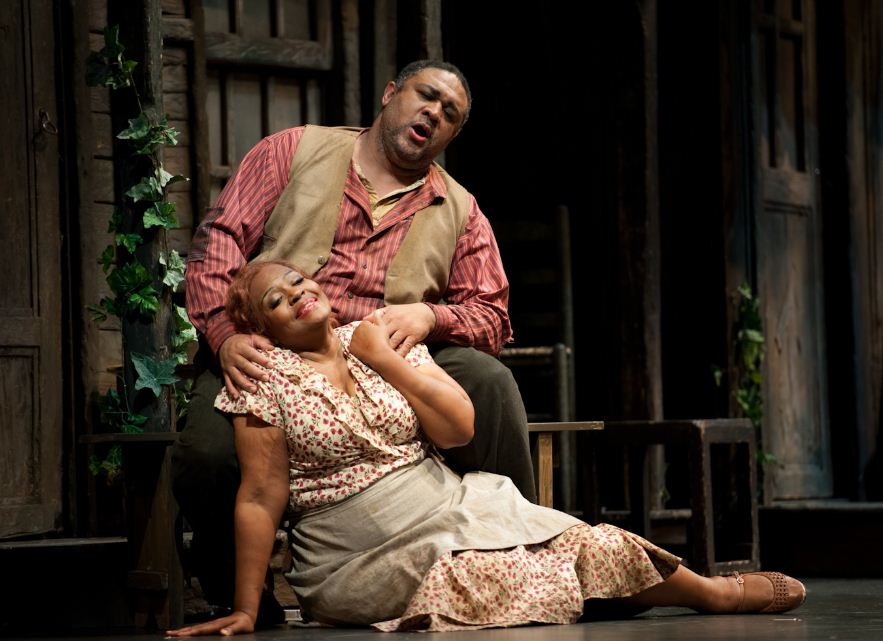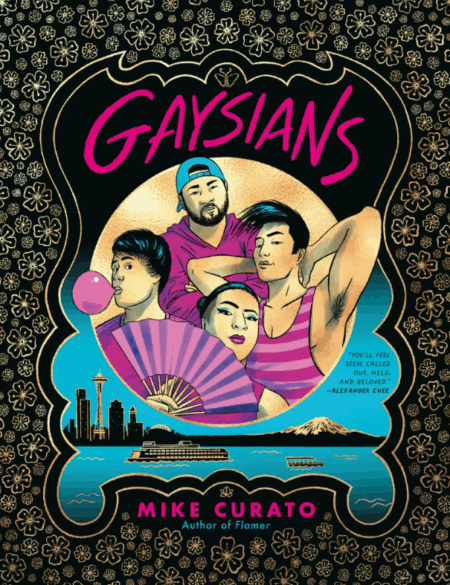Review: Porgy and Bess by George Gershwin, Dubose and Dorothy Heyward, and Ira Gershwin. Directed by Chris Alexander. Conducted by John DeMain. With Gordon Hawkins, Lisa Daltirus, Jermaine Smith, Michael Redding, Mary Elizabeth Williams, Angel Blue, Donovan Singletary, and Gwendolyn Brown. Produced by Seattle Opera at McCaw Hall through August 20. In English with English Captions.

Gordon Hawkins (Porgy) and Lisa Daltirus (Bess) in Seattle Opera's production of "Porgy and Bess".© Elise Bakketun photo
It’s not that summery in Seattle this year but Seattle Opera’s current production of George and Ira Gershwin’s folk opera, Porgy and Bess features the best song about summer ever written, the opening number “Summertime” and the weather is indeed fine in this lushly produced and performed gem of American art. The last few Seattle Opera productions were a bit on the bland side for me, but Porgy and Bess features the company at its best with a largely excellent company of singers, under the assured direction of Chris Alexander and the baton of conductor John DeMain and featuring strong design work from Michael Scott (sets), Christina Giannini (costumes) and Duane Schuler (lighting). After a bumpy 75 years of history, Porgy and Bess is firmly established in the canon of great operatic works of art and Seattle Opera’s production is a worthy example of why it belongs in that pantheon.
I loathe reviews that spend 2/3 of the piece on a synopsis of the production being reviewed, especially when it’s a “classical” work any semi-well educated person should be aware of. If you don’t know the story of Porgy and Bess…check out Wikipedia; that’s what it’s there for. But, to be kind, I’ll briefly catch you up the essentials. It’s 1930ish and we’re in Charleston, South Carolina in a port side slum known as “Catfish Row” home to a neighborhood of working class African-Americans who either work the docks, or on fishing boats. There are some exceptions though…Porgy is crippled and makes his living as a street beggar; he’s honest and well-liked but tends to keep to himself. Spotin’ Life is the jovial neighborhood drug dealer and Crown is the neighborhood bully involved in various underhanded schemes with his own victimized “moll” at his side, Bess. The plot of Porgy and Bess takes off when Crown gets involved in an argument during a craps game, and kills a man, forcing him to go on the lam and leaving Bess to fend for herself in a neighborhood where the respectable people despise her. Only Porgy is willing to take her in and soon they fall in love. But, it’s an opera so things have to go sour or you’re left with a 20 minute show… Cocaine addiction, a funeral, a hurricane, some more deaths and the return of Crown all present obstacles for the future happiness of Porgy and “his” Bess. The final outcome seems pretty bleak for the two, but the opera ends on a (very) slight note of hope, that Porgy will eventually be reunited with his woman.
Seattle Opera’s production of Porgy and Bess manages to avoid most of the pitfalls and controversies of staging the piece. Porgy and Bess has been plagued with accusations of racism from some quarters since the day it was first produced and there are certainly potential dangers that have to be avoided to successfully present the work in the 21st Century. Director Chris Alexander went to South Carolina to do research on the time and setting of Porgy and Bess and his diligent homework pays off for the most part. The performers by and large do not speak or sing in traditional African American, Southern dialects of the era, a bone of contention for many people in the African American community to avoid stereotypical portrayals in the line of Stepin Fetchit or Amos n’ Andy. I think at times, they err too much on the side of caution; there are performances that don’t attempt any sort of regional accent; some characters don’t even seem like they’ve BEEN to the South, let alone lived there and at times, it seems too deliberate of a choice. It’s understandable why you wouldn’t want to affect racially insensitive accents, but there are performances that might have benefited from a bit more Southern inflection.
More after the jump.
Care has also been taken to avoid stereotyped scenes of superstition or overtly emotional or reactive behavior; scenes involving the ominous arrival of a vulture, and the scenes set during the hurricane are carefully presented and staged. The citizens of Seattle Opera’s Catfish Row are presented as REAL people; a community of hardworking, everyday families gripping with problems common to every community: bills, jobs, family life, religion, sex, birth and death. And, like every community, not every member of a community is an ideal citizen. Every town has a version, or two, of a Crown or a Sportin’ Life or someone who isn’t strong enough to escape their influence, like Bess. Porgy and Bess IS a universal story set in a very specific culture. It’s what helps make it great.
Well, that and the beautiful music by the Gershwin brothers. And, the excellent cast who sings those numbers including Angel Blue’s lovely and haunting opening lullaby of the aforementioned “Summertime” and the charming swagger and charisma of Donovan Singletary as her hunky fisherman husband Jake; both performers made a compelling stage couple. Gwendolyn Brown’s Maria was also a huge crowd pleaser as the neighborhood matriarch with a performance both comedic and warmly touching. Not to mention Mary Elizabeth Williams as Serena who nearly stops the show with her achingly beautiful performance as the grieving widow of the man Crown kills. The ovation was long and embracing at the conclusion of her “Gone, Gone, Gone” aria. It was breathtakingly beautiful.
As the villains, both Michael Redding as the murderous Crown and Jermaine Smith as Sportin’ Life were superb. Mr. Smith has made a career of playing the role at opera houses around the world, but his performance was fresh, vital and engaging. Sportin’ Life is a despicable character of the sort you love to hate and you end up adoring Mr. Smith’s sly take on the role; the evils of a drug peddler are made all the more horrific by the charm and charisma of the man selling “Happy Dust”. And, Mr. Redding’s rich, powerful baritone and commanding stage presence only add to his performance as Crown, making the character complex and robust and not just a stereotype of an opera villain.
Oddly, the weakest elements among the performances in Porgy and Bess were by the actor/singers PORTRAYING Porgy and Bess and the problems, for me, were related to audibility, energy and casting. Gordon Hawkins imbues Porgy with a strong sense of honor and nobility, but the performer “reads” as being older than the other characters. His Porgy seems to not only be crippled, but elderly and tired like a 60 year old man just wishing people would leave him alone and lacking the vitality of characters that are supposed to be his peers. And, while Mr. Hawkins had strong projection during his bigger vocal moments, he was sometimes difficult to hear during normal passages. (At first I blamed my aging ears and the less than ideal acoustics of McCaw Hall, but my companion for the evening is mid thirties and she had issues with volume from Mr. Hawkins as well.)
And, the low energy levels from Porgy seemed to affect his Bess as well. Lisa Daltirus was a bit low key and understated as Bess and the chemistry between the two performers was low wattage and not overly passionate. The dynamic between the two seemed like Bess was Porgy’s nice niece caring for an aging uncle and not as besotted lovers. Ms Daltirus was also a bit difficult to understand at times; some of her phrasing was on the mushy side. Her stage presence was more interesting and electric and her performance stronger, in her scenes with Sportin’ Life and Crown and the soprano was at her strongest with Mr. Redding in Act II’s Kittiwah Island seduction/rape scene where she excelled both vocally and dramatically. The lack of chemistry between Ms Daltirus and Mr. Hawkins prevents this production of Porgy and Bess from reaching its full potential.
The design aspects by and large, DO realize their full potential with excellent lighting design by Duane Schuler and set design by Michael Scott particularly in the Kittiwah Island scene, the only moment in the opera set away from Catfish Row. The evocative lighting and lush suggestions of the overgrown, South Carolina jungle were hauntingly beautiful and made for an excellent contrast with the ramshackle formality of the urban setting of the other scenes. Christina Giannini’s costumes were ideally suited for the scope of this production; they remain rich and evocative but never overwhelm the characters or the setting and the designer appropriately dresses each character and underlines not only the emotional underpinnings of each character but their physicality as well. All in all, excellent work from all the designers and the staff who made it possible.
Seattle Opera’s Porgy and Bess was my first complete, live viewing of the Gershwin classic and it’s an excellent introduction to a vital part of not only the opera canon but as a piece of American art that relates to not only the African American experience, but the history of our country as a whole. Well, that and all that gorgeous music. It’s well worth checking out, not only for opera lovers, but for every theater goer who enjoys a rich, complicated piece of drama.














